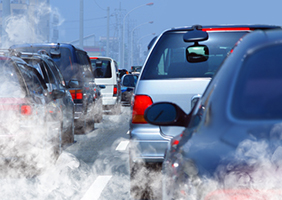 Since arthritis mostly attacks your joints and muscles, paying attention to your breathing may be the last thing on your to-do list.
Since arthritis mostly attacks your joints and muscles, paying attention to your breathing may be the last thing on your to-do list.
But air pollution can be as damaging to your joints as it is to your lungs, according to a flurry of recent research. But it’s probably in a different way than you think.
In New Delhi, India, a city with some of the highest levels of pollution particulates in the world, researchers found a spike in symptom flare-ups in RA patients during peak air pollution months. This has led to a theory that the problem may stem from particulate matter – soot, smoke, dust, and dirt particles suspended in the air.
Exhaustive Evidence
Pollution from vehicle exhaust, and therefore living near a busy road or highway, seems to be the main culprit.
According to the U.S. Nurses Health Study, participants who lived within 50 meters of a highway had 1.62 times the risk of developing RA compared to their counterparts who lived further from the nearest busy road.
Residing more than 150 meters from a highway places you well into the arthritis-free zone, with regard to road and vehicle particulates.
A lot of evidence points to cadmium, a toxic metal found in gasoline as well as automobile parts such as tires, brake pads, radiators and paints.
Other particulates in air pollution that can contribute to the development of RA include nitrates, sulphur dioxide, ozone, and carbon monoxide.
How It Happens
So, how is it that RA gets its start in the lungs?
The answer can be found where the immune system, the environment, and genetics meet. Some RA patients lack the ability to produce certain detoxifying enzymes, making them more vulnerable to the damaging effects of pollutants.
If you are one of those individuals and you are exposed to certain airborne toxins, notably the ones found along highways, some of your body’s own proteins can become damaged. When this occurs, the immune system tags the altered proteins as foreign substances and attacks them. In the case of RA, the first cells that come under attack are those of the capsules that surround and protect the joints.
The Vitamin D Connection
Also, air pollutants that settle on the skin, such as ozone, nitrates, and sulphates, are capable of absorbing ultraviolet rays, making them unavailable for your skin to convert into vitamin D.
One of the functions of vitamin D is to modulate the immune system in ways that counteract autoimmune processes and prevent autoimmune diseases. Fortunately, you can remedy vitamin D deficiency easily and cheaply and decrease your risk of developing RA by taking a high-quality vitamin D supplement.

 Overcoming IBD
Overcoming IBD Multiple Sclerosis
Multiple Sclerosis Banishing Bronchitis
Banishing Bronchitis Gum Disease Gone
Gum Disease Gone Overcoming Onychomycosis
Overcoming Onychomycosis Neuropathy No More
Neuropathy No More The Prostate Protocol
The Prostate Protocol Brain Booster
Brain Booster
 Ironbound
Ironbound
 Solution for Shingles
Solution for Shingles
 The Bone Density Solution
The Bone Density Solution
 The Ultimate Healing Protocol
The Ultimate Healing Protocol
 The Parkinson's Protocol
The Parkinson's Protocol
 The Chronic Kidney Disease Solution
The Chronic Kidney Disease Solution
 Overthrowing Anxiety
Overthrowing Anxiety The Fatty Liver Solution
The Fatty Liver Solution The Hypothyroidism Solution
The Hypothyroidism Solution
 The End of Gout
The End of Gout The Blood Pressure Program
The Blood Pressure Program
 The Oxigized Cholesterol Strategy
The Oxigized Cholesterol Strategy
 Stop Snoring And Sleep Apnea Program
Stop Snoring And Sleep Apnea Program
 The Arthritis Strategy
The Arthritis Strategy The Vertigo & Dizziness Program
The Vertigo & Dizziness Program The 3-Step Diabetes Strategy
The 3-Step Diabetes Strategy Hemorrhoids Healing Protocol
Hemorrhoids Healing Protocol The Erectile Dysfunction Master
The Erectile Dysfunction Master Weight Loss Breeze
Weight Loss Breeze The IBS Program
The IBS Program The Insomnia Program
The Insomnia Program The Migraine and Headache Program
The Migraine and Headache Program The Neck Pain Solution
The Neck Pain Solution The Menopause Solution
The Menopause Solution The Ejaculation Master
The Ejaculation Master The TMJ Solution
The TMJ Solution The Acid Reflux Solution
The Acid Reflux Solution The Fibromyalgia Solution
The Fibromyalgia Solution The Psoriasis Strategy
The Psoriasis Strategy